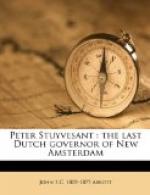In the year 1665, the year which followed the capture of the city, war broke out between England and Holland. It was then generally expected that the States of Holland would make an attempt to recover the lost territory of New Netherland. It was rumored that De Ruyter, one of the Dutch Admirals, had actually set sail, with a large squadron, for New York. The rumor caused great commotion in the city. The national spirit of the Dutch residents was roused to intensity. De Ruyter had indeed sailed with the object of recapturing the province.
Colonel Nicholls was a man of great energy. He immediately commenced with all vigor, the work of repairing the crumbling fortifications, and of erecting new ones. But he found none to co-operate heartily with him, save the few English soldiers, whose bayonets held the conquered province in subjection. A meeting of all the Dutch inhabitants was called to ascertain the tone of public sentiment, and to endeavor to inspire the community with some enthusiasm for the defence.
But no enthusiasm was elicited. The Dutch were not at all unwilling that their countrymen should come back and reclaim their own. Even to defend themselves from the humiliation of conquest, by their English assailants, they had not been willing to submit to a bombardment. Much less were they now willing to subject themselves to the horrors of war, when the flag of Holland was approaching for their deliverance. They did not venture however, openly to oppose the ruler whom the fortunes of war had set over them, or to express sympathy for the success of the approaching fleet, which might be pronounced treason, and might expose them to severe punishment.
They contented themselves with manifesting entire indifference, or in offering sundry excuses. They very sensibly assumed the ground that they were a feeble defenceless colony, far away in the wilderness, entirely unable to cope with the forces which the great maritime powers of England or Holland might send against them. When an English fleet opened the portholes of its broadsides upon their little village, they could do nothing but surrender. Should a fleet from Holland now anchor in their waters they must let events take their natural course.




